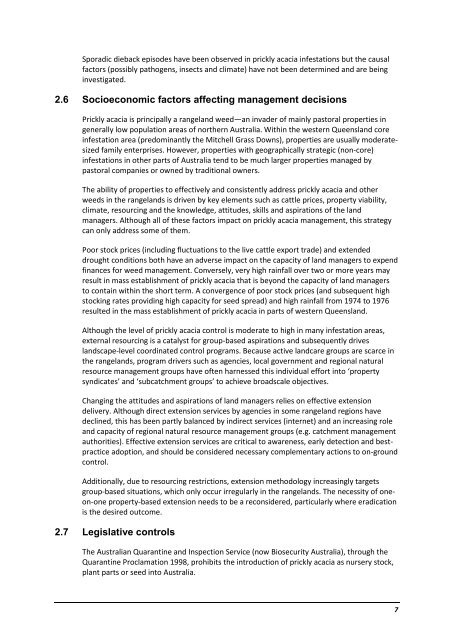Report Title - Weeds Australia
Report Title - Weeds Australia
Report Title - Weeds Australia
You also want an ePaper? Increase the reach of your titles
YUMPU automatically turns print PDFs into web optimized ePapers that Google loves.
Sporadic dieback episodes have been observed in prickly acacia infestations but the causalfactors (possibly pathogens, insects and climate) have not been determined and are beinginvestigated.2.6 Socioeconomic factors affecting management decisionsPrickly acacia is principally a rangeland weed—an invader of mainly pastoral properties ingenerally low population areas of northern <strong>Australia</strong>. Within the western Queensland coreinfestation area (predominantly the Mitchell Grass Downs), properties are usually moderatesizedfamily enterprises. However, properties with geographically strategic (non-core)infestations in other parts of <strong>Australia</strong> tend to be much larger properties managed bypastoral companies or owned by traditional owners.The ability of properties to effectively and consistently address prickly acacia and otherweeds in the rangelands is driven by key elements such as cattle prices, property viability,climate, resourcing and the knowledge, attitudes, skills and aspirations of the landmanagers. Although all of these factors impact on prickly acacia management, this strategycan only address some of them.Poor stock prices (including fluctuations to the live cattle export trade) and extendeddrought conditions both have an adverse impact on the capacity of land managers to expendfinances for weed management. Conversely, very high rainfall over two or more years mayresult in mass establishment of prickly acacia that is beyond the capacity of land managersto contain within the short term. A convergence of poor stock prices (and subsequent highstocking rates providing high capacity for seed spread) and high rainfall from 1974 to 1976resulted in the mass establishment of prickly acacia in parts of western Queensland.Although the level of prickly acacia control is moderate to high in many infestation areas,external resourcing is a catalyst for group-based aspirations and subsequently driveslandscape-level coordinated control programs. Because active landcare groups are scarce inthe rangelands, program drivers such as agencies, local government and regional naturalresource management groups have often harnessed this individual effort into ‘propertysyndicates’ and ‘subcatchment groups’ to achieve broadscale objectives.Changing the attitudes and aspirations of land managers relies on effective extensiondelivery. Although direct extension services by agencies in some rangeland regions havedeclined, this has been partly balanced by indirect services (internet) and an increasing roleand capacity of regional natural resource management groups (e.g. catchment managementauthorities). Effective extension services are critical to awareness, early detection and bestpracticeadoption, and should be considered necessary complementary actions to on-groundcontrol.Additionally, due to resourcing restrictions, extension methodology increasingly targetsgroup-based situations, which only occur irregularly in the rangelands. The necessity of oneon-oneproperty-based extension needs to be a reconsidered, particularly where eradicationis the desired outcome.2.7 Legislative controlsThe <strong>Australia</strong>n Quarantine and Inspection Service (now Biosecurity <strong>Australia</strong>), through theQuarantine Proclamation 1998, prohibits the introduction of prickly acacia as nursery stock,plant parts or seed into <strong>Australia</strong>.7
















